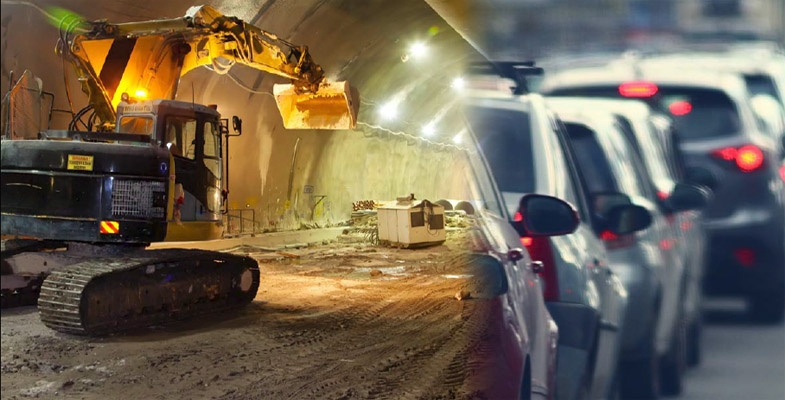The state and federal governments are unwilling to discuss the issue of Australia’s population growth. The general view is that the greater the growth the more we will all benefit. Of course their only interest is the simple notion of economic growth, not social wellbeing or environmental quality. Actually economic growth has not been great either. The fact that economic growth per capita has not kept up with inflation has been conveniently ignored.
Australia’s population grew by an average of 400,000 over each of the last five years to reach 25.4 million at 30 June 2019. 60% of this growth is from net overseas migration. This is adding another Canberra every year. The prospect that our population could reach 60 million by the end of the century doesn’t seem to worry the politicians. They appear to believe that this is a fact of life.
Sustainable Population Australia commissioned a report on the infrastructure needs of Australia following the increase in our growth rate this century. The report by Leith van Onselen from business analysis firm Macrobusiness found that unless Australia's population growth is substantially reduced, it is an illusion to believe that infrastructure will ever catch up.
Amenity for people in our major cities is being eroded through increasing congestion and road tolls, declining housing affordability and loss of green space. The whole country is having to bear the growing infrastructure costs.
The report estimates that each additional person requires at least $100,000 worth of additional public infrastructure to maintain the current standard of living. Governments have been trying to catch up with a backlog of infrastructure that developed during the early part of this century. Some progress is being made but we will be forever trying to catch up to cater for the new residents.
The Bureau of Infrastructure, Transport and Regional Economics estimated that congestion costed the Australian economy $16.5 billion in 2015. Moreover, without major policy changes, congestion costs are projected to reach $27 to $37 billion by 2030. Similarly, Infrastructure Australia, in its 2019 infrastructure audit, estimated that the annualised cost of traffic congestion and public transport crowding in Australia would rise from $19 billion in 2016 to $39.6 billion in 2031. These congestion pressures will be particularly acute in Sydney and Melbourne.
The cold hard truth is that the quantity of infrastructure investment required for a big Australia is mind-boggling.
The volume of population growth into Sydney and Melbourne needs to be put into perspective:
- It took Sydney roughly 210 years to reach a population of 3.9 million in 2001. Yet the official medium projection by the ABS has Sydney reaching roughly 2.5 times that number of people in only 65 years.
- It took Melbourne nearly 170 years to reach a population of 3.3 million in 2001. The official medium ABS projection, however, has Melbourne’s population tripling that number in only 65 years.
In the face of these unprecedented numbers, the key difference between then and now needs to be underlined: unlike the post-war period, it is no longer easy to further expand the capacities of our largest cities. What was an abundant supply of cheap frontier land in the 1950s and 1960s is now well and truly built-out. Both cities are now sprawling metropolises with greenfield land in short supply. Ever-longer commutes erode productivity, and ever-greater distances between rich and poor neighbourhoods entrench disadvantage. New infrastructure investment necessarily requires costly solutions like land acquisitions and tunnelling in order to retrofit projects into existing suburbs.
Some recent examples are stark. The WestConnex project in Sydney will reportedly cost $17 billion for 33 km ($515 million per kilometre) while Melbourne’s West Gate Tunnel is expected to cost $6.7 billion for five kilometres of highway ($1.34 billion per kilometre). In contrast, the 155 km Woolgoolga to Ballina highway upgrade, a surface road, costs $4.9 billion, or just $32 million per kilometre (approximately 16 times less than WestConnex, and 42 times less than the West Gate Tunnel, on a per kilometre basis). And yet, with all of this current and proposed investment, of increasing orders of magnitude, congestion is still expected to increase.
The Productivity Commission has reported several times on the costs and benefits of immigration and has found little if any net benefit for the existing population. It has also added an important caveat, namely that it has not taken the infrastructure or environmental costs into its analyses because of the complexity of doing so
There are two myths that the government keeps on spruiking as the solution. Again these were the findings of a COAG report.
Invest in Infrastructure and Plan Better
The SPA report demonstrates that this is impossible with the current growth rate.
Settle New Migrants in Regional Areas
There is no way of keeping migrants in regional areas when there is not enough employment. Cutting Sydney’s population by 40,000 would not be noticed but the addition of that many people to a centre like Orange would double its current numbers. Most regional centres do not have enough water supply to cater for a large increase in population. Much of regional Australia is located far away from the ocean, meaning that desalination of seawater is not an option, and large-scale desalination of groundwater for inland towns is unlikely to be feasible or ecologically sustainable.












